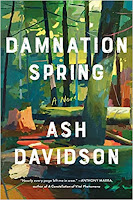Elle & Coach: Diabetes, The Fight for My Daughter's Life, and the Dog Who Changed Everything, by Stefany Shaheen (Hachette, 2015, 229 pages, $27) Elle and her mother are interviewed on C-SPAN here.
Can we pick not one but two Books of the Year in just the first two months?
We nearly did! And Elle & Coach may be it. We had started this book years ago and loved it but put it aside for some reason until we finally picked it up again and raced through it in a couple of hours. And cried all the way through, it is such a lovely book.
Author Stefany Shaheen, Senator and former Governor Jeanne Shaheen's daughter, is mother to Elle, eight years old when the story opens. Living in New Hampshire, they have a huge extended family and live in New England near many excellent hospitals.
What is Diabetes Mellitus?
First of all, diabetes 1 is generally hereditary and diagnosed in childhood while diabetes 2 is adult-onset and usually caused primarily by obesity or other lifestyles. In both types, your pancreas doesn't produce enough insulin to control the amount of glucose (a sugar) in your blood. You are very thirsty and have to urinate more, you are hungry yet lose weight, may have vision problems, fatigue, very dry skin and may lose feeling in your hands or feet. Elle gradually lost weight and would get up in the middle of the night to go to the bathroom and drink copious amounts of water. She had trouble seeing and her grades were plummeting.
So, What Happened?
Elle experienced some of these symptoms gradually and others rapidly over a few days and fortunately was hospitalized for a week to get her insulin dosage under control. Diabetes is especially inconvenient for children in large active families for these kids need blood checks several times a day to determine the amount of insulin needed depending on varying physical activity, stress, food, and snacks. Too much glucose can result in coma while too little can result in seizures, both of which is a heavy burden for a child and her family.
Enter Coach!
Fortunately, dogs have the ability to detect (most likely by their incredibly sensitive sense of smell) when someone's blood sugar is too high or too low - usually before the person himself is aware of it. Dogs can be trained to alert the person to check his blood sugar and to treat it.
Coach is one such DAD, diabetic alert dog, trained by CARES, a service dog organization in Kansas.
After living with diabetes for five years, Elle's family learned about DADs and were put on a waiting list for a trained medical alert service dog. Within the first 24 hours of their being matched up, Coach saved Elle's life and continues to do so, allowing Elle to live a more normal life. They are together 24/7 and have a deep relationship. This has been a lifesaver for Elle. As a matter of fact, last year's article on Elle in the Harvard Crimson, about her senior thesis does not even mention her diabetes.
Now, Back to the Book
The reader will experience childhood diabetes and how it was detected in Elle (whose uncle also had diabetes 1), will come to understand how it affects family routines and relationships, and, finally, how a service dog can help a child feel more normal again as well as keep the child safe, healthy and perhaps alive (Elle even meets President Obama and Michael J. Fox). You will go through the anxiety and fear of not knowing what is wrong with your child, the constant worry about one child more than the others, the stress of getting up in the middle of the night to check on that child, having to make sure she has test strips and candy at all times, is warm enough and doesn't overdo it, and learn how to determine the amount of various ingredients in different foods and their amounts. And still, the disease can surprise you with a crisis that you blame yourself for.
Is Elle & Coach a Dog Book?
Primarily, it is about a little girl and her mother, and family, but also about a dog. If it were a dog book, it would have been titled, Coach & Elle, rather than Elle & Coach. We don't even hear about DADs until nearly halfway through the book, and then, life with Coach seems too cursory for dog people, even if she is a beautiful yellow labrador retriever, America's favorite. And, besides being a service dog, Coach is well-loved as a family pet.
Who Else has Diabetes?
Mary Tyler Moore, Justice Sonia Sotomayor, Jean Smart of Designing Women, Olympic swimmer Gary Hall, Miss Idaho Sierra Sanderson, Miss America Vanessa Williams all have (had) 'childhood' diabetes while these famous people have adult-onset diabetes 2: Tom Hanks, Halle Berry, Larry King, Patti LaBelle, Drew Carey, and Dick Clark. Obviously, it is a chronic condition you can live with.
What We Liked
The suspense, even though we know how it ends.
What We Would Change
We, being dog people, would reverse the focus and put more of it on Coach. However, the depiction of Coach first saving Elle's life in their first 24 hours together should be a short story everywhere - in Reader's Digest, in documentaries, on news reports, in the Dodo and Huffington Post.
Nevertheless, . . . .
If you love dog memoirs or know someone with diabetes, this is one darn good dog book and highly inspirational.























